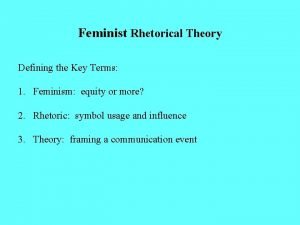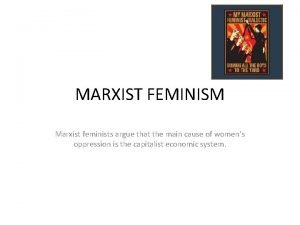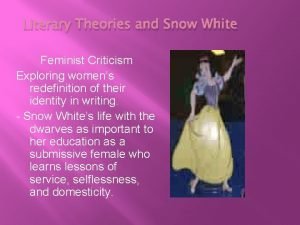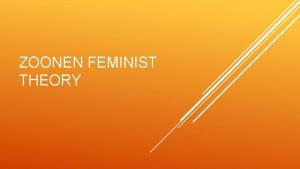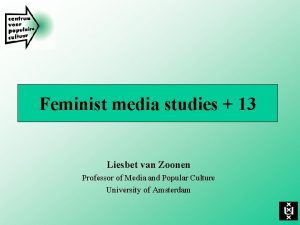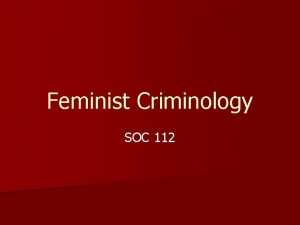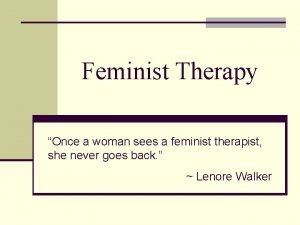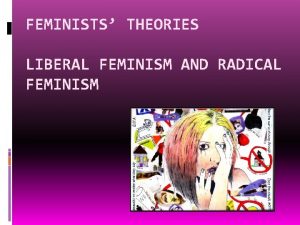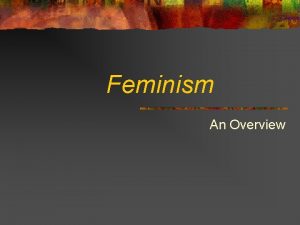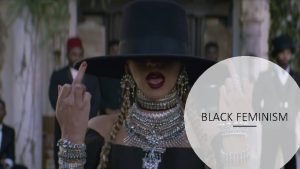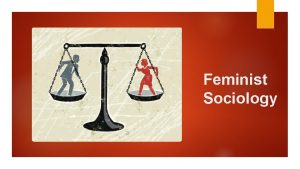Feminist Theories Unit 1 Feminism Feminist Theory Feminism










- Slides: 10

Feminist Theories Unit 1: Feminism & Feminist Theory

Feminism Re-Cap: ¡Organized movement promoting equality for men & women in political, economic & social spheres. ¡Feminists believe women are oppressed due to their sex based on dominant ideology of patriarchy. ¡Ridding society of patriarchy results in liberation for women, minorities, and gays.

Feminism Re-Cap (cont’d): ¡Patriarchy is the system that oppresses women through its social, economic & political institutions. ¡History tells us men have had greater power in both public and private sectors. To maintain this power, men have created boundaries and obstacles for women, thus making it harder for women to hold power. Unequal access to power. ¡Patriarchy also includes oppression of minorities and homosexuals.

Taking on many different forms… ¡ Feminism ideology can take on many different forms. ¡ 1970 s: women started developing a theory which helped to explain their oppression. ¡ Pockets of resistance began to organize and challenge patriarchy. ¡ 1980 s: feminists started disagreeing on particular issues linked to feminism. ¡ One theory branched to many theories focusing on different feminist issues. ¡ Definitions of feminism depend on a number of factors including one’s own beliefs, history & culture.

Theorists & Theoretical Perspectives ¡ Dorothy Smith: ¡ Canadian sociologist ¡ Provocatively blends neo-Marxist, phenomenological, and ethnomethodological concepts & ideas. ¡ Marxist: worldview and method of societal analysis that focuses on class relations and societal conflict, that uses a materialist interpretation of historical development. ¡ Neo-marxist: of or relating to forms of political philosophy that arise from the adaptation of Marxist ¡ Phenomenological: The study of consciousness and the objects of direct experience. ¡ Ethnomethodological: focuses on the way people make sense of their everyday world. People are seen as rational actors, but employ practical reasoning rather than formal logic to make sense of and function in society.

Theorists & Theoretical Perspectives ¡Patricia Hill Collins: ¡ African-American sociologist ¡ Extends the work of Smith by formally situating the variable of race into the critical/phenomenological exploration of class and gender ¡ Borrows significantly from postmodernism and recent work on the body and sexuality

Theorists & Theoretical Perspectives ¡Raewyn Connell ¡ Australian sociologist ¡ Challenge the prevailing “sex/gender” dichotomy, i. e. , the notion that “sex” is the biological difference between “Male” and “Female” human animals, while “gender” is the social difference “between males’ and females’ roles or men’s and women’s personalities” (Connell & Butler) ¡ Explains that men and boys are gatekeepers for gender equality. ¡Judith Butler ¡ American philosopher ¡ Challenges very binary categories that we use to think about both gender & sexual orientation.

Extended Responses Read the Biographical Sketch, Theoretical Orientation, and Articles provided for each of the following theorists. Write an extended response responding to the questions listed following the readings. ¡Dorothy Smith: Page 318 -332 ¡Patricia Hill Collins: Page 332 -346 ¡Raewyn Connell: Page 359 -372 ¡Judith Butler: Page 372 -380

Extended Response #1: ¡According to Smith (1987: 68), “The role of women is central both in the work that is done and in the management of its routine daily order… whatever the relations between school achievement, career success, and the ‘intricate psychosocial processes’ of the family, the conscious, planned thoughtful work of women as mothers has been part of its actuality. ” Discuss the extent to which “behind-the-scenes” women’s work is still taken for granted in both schools and the workplace today, including the class dimensions of this issue. Do you think that this aspect of gender roles has changed in the last twenty years? How so or why not? Do you think full gender equality can be achieved? Why or why not?

Extended Response #2: According to P. Collins (1990/2000: 228), “A matrix of domination contains few pure victims or oppressors. Each individual derives varying amounts of penalty and privilege from the multiple systems of oppression which frame everyone’s lives. ” Give concrete examples of moments or situations in which you have found yourself a “victim” and concrete examples of moments or situations in which you found yourself an “oppressor”. Explain how your examples reflect the matrix of domination at the level of personal biography, the community, and the systemic level of social institutions. http: //www. sagepub. com/upm-data/38628_7. pdf
 Feminist rhetorical theories
Feminist rhetorical theories Marxist feminism theory
Marxist feminism theory Snow white from a feminist perspective
Snow white from a feminist perspective Van zoonens theory
Van zoonens theory Liesbet van zoonen feminist theory
Liesbet van zoonen feminist theory Anneke smelik feminist film theory
Anneke smelik feminist film theory Feminist theory criminology
Feminist theory criminology Setting of the story of an hour
Setting of the story of an hour What is post feminism
What is post feminism Characteristics of patriarchy
Characteristics of patriarchy Principles of feminism
Principles of feminism
